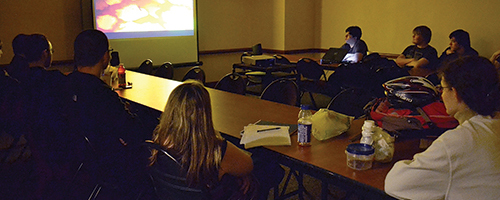Asbestos haunts aging Portland State buildings
In early September, workers installing data jacks for a video projection system in Neuberger 407 tapped into an unwelcome substance in the walls: asbestos.
“They knew it was there,” said Rose Wooderson, office manager for the English department. “The project included asbestos abatement work.”
But the work took longer than originally planned. Staff in the English department were told to stay out of the room but weren’t sure how critical the issue was, or whether or not doors to the room should be left open or closed.
“The workers disappeared for awhile,” Wooderson said. “When they came back they told us not to worry, that they were going to vacuum out the holes and spray them with water.”
Asbestos is a known health risk for humans. People who inhale asbestos may develop life-threatening illnesses, including lung cancer, mesothelioma and a destructive lung disease known as asbestosis.
Asbestos is the generic term for the fibrous variety of six naturally occurring minerals that are flexible, have a high tensile strength and resist chemical, electrical and heat or fire degradation.
These qualities make asbestos ideal for many industrial uses, including insulation, fireproofing, floor tiles, roofing shingles, acoustic ceiling plaster, chalkboards and wall materials.
“Asbestos exists in Neuberger Hall and other campus buildings,” Robyn Pierce, interim director of Facilities and Planning, said in an e-mail.
The asbestos in Neuberger is part of the ductwork wrapping, and may also be a part of the wallboard and other building materials.
“Asbestos is probably in all of the old buildings on campus,” said Scott Burns, professor of geology at PSU. “Its use in building materials was outlawed in the 1980’s by the EPA, so no new buildings will contain it.”
According to the United States Occupational Safety and Health Administration (OSHA), a branch of the Department of Labor, some of the heaviest occupational exposures to asbestos occur during the removal of in-wall asbestos as a part of building renovations.
“We routinely remove asbestos when working in areas and also when the material begins to break down and become a hazard,” Pierce said.
Exposed asbestos tends to separate into microscopic threads that remain in the air and are easily inhaled. A single fiber when lodged in the lungs has been known to cause illnesses, which may take years to show up.
Because of these risks, OSHA guidelines mandate the use and handling of asbestos, as well as environmental testing procedures following asbestos exposure. OSHA also sets specific guidelines relating to human asbestos contact and notification of the presence of asbestos.
“Not all asbestos is dangerous or cause for alarm,” Pierce said. Proponents argue that when contained within a closed space or confined in a controlling matrix, asbestos cannot be disseminated into the air.
Burns pointed out that there are two types of asbestos. White asbestos (chrysotile), which makes up 90 percent of asbestos used in U.S. buildings, is not a major health hazard. Brown asbestos is the bad one and is known to cause cancer and asbestos-related diseases.
However, some research has shown that every kind of asbestos can cause cancer and that there is no such thing as a safe level of exposure to asbestos, either in terms of the substance itself or the duration of exposure.
“Ideally, the only safe form of asbestos is no asbestos,” states the Communication Worker’s Union web site. According to OSHA guidelines, “Building and facility owners shall determine the presence, location, and quantity of asbestos-containing materials and/or presumed asbestos-containing materials at the work site. Employers and building and facility owners shall exercise due diligence in complying with the requirements to inform employers and employees about the presence and location of ACM and PACM.”
“It’s when asbestos gets released into the air as dust that it causes problems,” Burns said. “It’s composed of minerals, so it doesn’t really decompose, either. Most of it is sent to the hazardous waste dump in Arlington and buried. I take my environmental geology class up there in November to see how the dump is run.”
According to OSHA, all buildings constructed before 1980 are presumed to include asbestos, particularly in thermal system insulation systems and surfacing materials.
Shattuck Hall, scheduled for extensive structural renovation in the coming months, is another campus building known to have an asbestos problem. In a March 2005 statement, PSU president Daniel Bernstine said, “There are safety concerns associated with Shattuck Hall. The building has asbestos floor tiles and asbestos wrap on all ductwork.”
Once it begins, Shattuck’s renovation will take 6-12 months.
As for Neuberger 407, the holes are still there, and the data port installation is not yet complete. However the Department of English has been advised that the room is now safe, and it is once again in regular use for meetings and classes.




